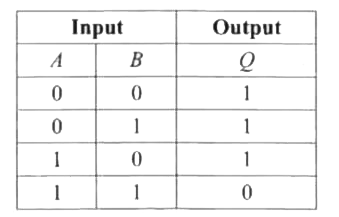In the following diagram for the first three periods of the periodic table, five elements have been represented by the letters a,b,c,d and e (which are not their chemical symbols):

(i) Select the letter which represents a halogen.
(ii) Select the letter which represents a noble gas.
(iii) What type of bond is formed between a and b?
(iv) What type of bond is formed between c and b?
(v) Which element will form a divalent anion?
(i) The halogens are placed in group 17. Now, in the above given table the element present in group 17 is b. Thus, the letter b represents a halogen.
(ii) The noble gases are placed in group 18 of the periodic table. In the above given table, the element placed in group 18 is e. Thus, the letter e represents a noble gas.
(iii) We have now to find the type of bond formed betwen the elements a and b. Now, if we look at the above given table, we find that element a is placed non-metal reacts with another non-metal, the covalent bonds are formed. So, the bond between a and b is covalent bond.
(iv) And now we have to find out the type of bond between the elements c and b. The element c is in group 2 so it is a metal. The element b is in group 17 so it is a non metal. We know that when a metal reacts with a non -metal, then an ionic bond is formed. Thus, the bond formed between the elements c and b will be ionic bond.
(v) We will now find out that element which forms a divalent anion. A divalent means a negative ion having 2 units of negative charge. A divalent anion is formed by a non-metal atom having 6 valence electrons (so that it can accept 2 more electrons to complete the octet and form a divalent anion). Thus a divalent anion will be formed by a non metal element of group 16 because it will have 6 valence electrons in its atom. Now, in the above given table, the elemented has been placed in group 16 of the periodic table, so element will form a divalent anion.
Topper's Solved these Questions
- PERIODIC CLASSIFICATION OF ELEMENTSBook:LAKHMIR SINGH & MANJIT KAURChapter:PERIODIC CLASSIFICATION OF ELEMENTSExercise:SHORT ANSWER TYPE
Explore 8 Videos
- PERIODIC CLASSIFICATION OF ELEMENTSBook:LAKHMIR SINGH & MANJIT KAURChapter:PERIODIC CLASSIFICATION OF ELEMENTSExercise:LONG ANSWER TYPE
Explore 3 Videos
- PERIODIC CLASSIFICATION OF ELEMENTSBook:LAKHMIR SINGH & MANJIT KAURChapter:PERIODIC CLASSIFICATION OF ELEMENTSExercise:VERY SHORT ANSWER TYPE
Explore 6 Videos
- METALS AND NON-METALSBook:LAKHMIR SINGH & MANJIT KAURChapter:METALS AND NON-METALSExercise:Short Answer Type Qustions
Explore 1 Video
- TEST PAPER 1Book:LAKHMIR SINGH & MANJIT KAURChapter:TEST PAPER 1Exercise:Section B
Explore 4 Videos
Similar Questions
The following diagram shows a part of the periodic table containing first there periods in which five elements have been represented by the letters a,b,c,d and e (which are not their chemical symbols):

(i) Select the letter which represents an alkali metal.
(ii) Select the letter which represents a noble gas.
(iii) Select the letter which represents a halogen.
(iv) What type of bond is formed between a and e?
(v) What type of bond is formed between d and e?
View SolutionA to F are the structural formulae of some organic compound

(i) give the letter which represent the family.
(ii) Give the letters which donot represent hydrocarbons.
(iii) How can 'C' be converted into 'A'?
View Solution
Knowledge Check
The letter D in carbohydrates represent its_________.
Aits direct synthesisBits dextrorotationCits mutarotationDits configurationThe letter 'D' in carbohydrates represents
AIts direct synthesisBits dextrorotationCits mutarotationDits configurationThe following truth table represents which type of gate?
 ANOTBANDCORDNAND
ANOTBANDCORDNAND
The following diagram shows a part of the periodic table in which the elements are arranged according to their atomic numbers. ( The letters given here are not the chemical symbols of the elements):
(i) Which elements has a bigger atom , a or f ?
(ii) Which element has a higer valency, K or o ?
(iii) Which element is more metallic, i or K ?
(iv) Which element is more non - metallic , d or g ?
(v) Select a letter which represents a non-metal of valency 2.
(vi) Select a letter which represents a noble gas.

View SolutionAn element A has an atomic number of 6. Another element B has 17 electrons in its one neutral atom.
(a) In which groups of the periodic table would you expect to find these elements?
(b) What type of bond is formed between A and B?
(c) Suggest a formula of the compound formed between A and B.
View SolutionIf d represents the bond length, then select the correct relation.
View SolutionWhich one of the following belongs to representative group of elements in the periodic table?
View SolutionWhich one of the following belongs to representative group of elements in the periodic table?
View Solution
